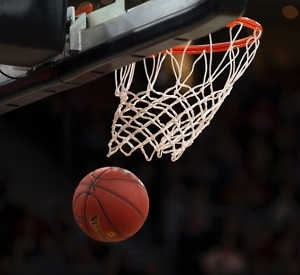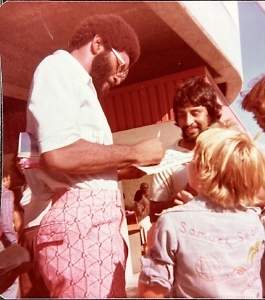My NBA Love Affairs
On finding the right team to root for
My football fandom was never in doubt. The son of two Texas Exes, season ticket holders who decorated our living room with burnt-orange regalia, I inherited Longhorn football the way I was bequeathed Mom’s eyelashes and Dad’s bad back.

No complaints, though. Dozens of my fondest childhood memories derive from singing “Texas Fight.” In City Slickers, Billy Crystal says the greatest day of his life was the first time his old man took him to Yankee Stadium and he watched Mickey knock one out of the park. For me, it was climbing with Dad to the upper deck of Memorial Stadium and watching Earl Campbell, a mythological figure with Paul Bunyan strength, Bevo standing in for Babe the Blue Ox.
For the NFL, too, volition played no part in my rooting interest. My adoring Aunt Ann who lived in Dallas bought me a subscription to Cowboys Weekly and took me to a game when I was in grade school. I still have a photo of little Sean waiting to get an autograph from Ed “Too Tall” Jones, an enormous defensive lineman whose electro-red pants and styled Afro date the period as mid-70s, the Roger Staubach era when Dallas regularly appeared in Super Bowls. Tony Dorsett, Drew Pearson, Randy White, Cliff Harris — those Cowboys manifested in my fantasy life, mythic figures to whom I owed unquestioned fealty.

With basketball, a sport unclaimed by Kinch forebears, the lines of loyalty were free. I took advantage of that bachelor status with years of wild promiscuity. I pledged my heart to Pete Maravich, but before the month was out betrayed him with Bob McAdoo. Longer dalliances with Tiny Archibald and Paul Westphal (as I’ve documented) were formative in my conception of ideal love. Some college heartthrobs — Goose Givens and Sidney Moncrief — attracted my interest as they made the transition to the NBA, but the passage of time often diminished the strength of my youthful fire; seeing them only made me long for the passion we once shared.
The exception to these adolescent vicissitudes was my ardor for Julius Erving, the ABA legend turned NBA all-star who seemed to float above his opponents. My love for Dr. J had no indie appeal — he wasn’t an eccentric taste or shadow figure from the demimonde. He was the most famous, highest paid, most emulated, coolest, baddest, Afro-fabulest basketball player on the planet. I didn’t care. My love for Erving translated into a temporary love for the Sixers, his team after a landscape-shifting move from the New Jersey Nets. In Philly he teamed up with players like George McGinnis, Bobby Jones, Caldwell Jones, Maurice Cheeks — how did those cats ever lose? Their playoff frustrations (most famously in the ’77 NBA Finals to the Trail Blazers) didn’t dampen my fiery affections. My loyalty was steadfast … until 1984, when Michael Jordan turned everyone’s heads and revolutionized the league.
But my story here is how, when I went to college in the Bay Area, I first felt connected to a team. Two factors, neither of which obtain today and both of which carbon-date me as a relic of the Mesozoic Era: The Golden State Warriors’ broadcast on a local station was an excuse for Stanford students to congregate in common rooms and eating clubs, a break from studying and a topic of conversation. Plus, the Warriors of 1986-87 were a lovable, ragtag, perennially second-tier squad whose best player, Eric “Sleepy” Floyd, was famous for having the league’s most apt nickname, the bags under his eyes making him appear perpetually just awakened from a peaceful nap.
That year the Warriors, a 5th seed, were overwhelmed in the Conference semi-finals by the mighty Lakers (who won the ’87 Finals over Boston). We didn’t care — we had all the triumph we needed when Sleepy scored 51, including 27 in the fourth quarter, in a Game 4 victory. I still remember my roommate Jacek, a Polish guy new to the sport but equal in his attachment to our hometown team, describing Sleepy’s miraculous play and ultimate exhaustion, collapsing into teammates’ arms and floating off the court to wild applause from the Oakland Coliseum crowd, none of them under the illusion that the Warriors would win the series. Let the Lakers have Magic, Kareem, and Worthy and their umpteen championship banners. We had Sleepy.

The tenor changed when Chris Mullin, Brooklyn native and star of St. John’s, emerged as the team leader. Matters intensified further in 1988 when the Warriors landed Mitch Richmond, All-American from Kansas State. We just needed someone to get them the ball. Warriors fans booed in 1989 when management selected Tim Hardaway with the 14th pick; I confess that I had my doubts when I saw his unorthodox free throws, a wrist-flip from his forehead that looked like a silly trick shot until you noticed that he made 85% of them. It took only a dozen games to see that Hardaway, a speedy ball-handling wizard and assist machine, was the engine we needed. Soon we were out-scoring opponents with a wide-open style — penetrate and dish, spread the floor, make the extra pass — that made the Warriors the most entertaining team in the league. Tim, Mitch, Chris: Run TMC. We all bought the poster.
The heroic eras of our youth never last as long as they should. Run TMC stayed together for a mere three seasons, 1989-91, but they happened to overlap with my senior year in college and later when Jacek and I and our roommate Sid lived together in Palo Alto. We had little money for going out but could stock our vintage fridge with Wiedemann’s “fine beer” and, several nights a week, eat from the 79-cent menu at Taco Bell and watch our beloved trio.
The Warriors are the team I chose, pressed on me by circumstance and embraced out of love. I rooted for the ‘Niners and Giants, as well, Bay Area fixtures with more cachet, but it was the Warriors I cleaved to my boyish heart with the intensity I once felt for the Longhorns and the Cowboys. That undiminished devotion has much to do with nostalgia.
When I see the Warriors now — again one of the NBA’s most appealing teams — I remember Jacek and Sid on our dorm couch, watching Run TMC on Sid’s 13-inch hand-me-down TV. We had a pair of pliers to change the channel after we broke off the knob. That image — late-80s college students huddled on ratty furniture watching tight-shorted professional ballers on a tiny screen — sounds as ancient to my children as my father’s stories of gathering around the radio to listen to “The Lone Ranger” sounded to me. All I can say is, don’t pity us — three nights a week we got to watch our heroes, NBA legends in their prime. You should be so lucky; you should care so much.

Copyright (c) 2022 by Sean Kinch. All rights reserved. Sean Kinch grew up in Austin and attended Stanford. He earned a Ph.D. from the University of Texas. He now teaches English at Montgomery Bell Academy in Nashville.


